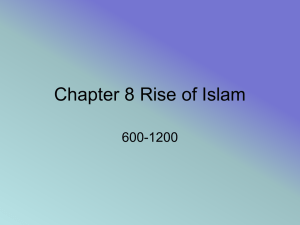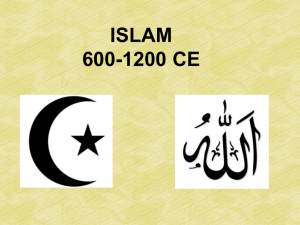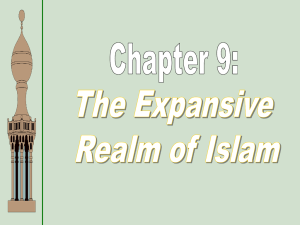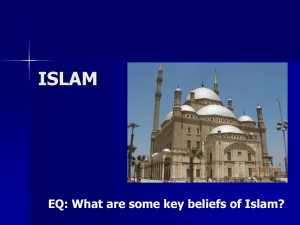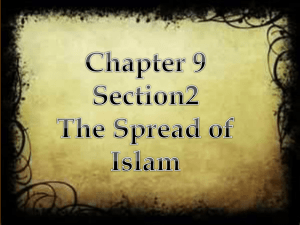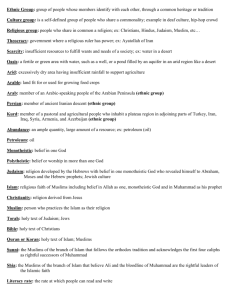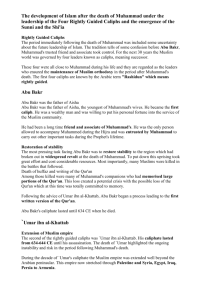Chapter 8 Notes
advertisement
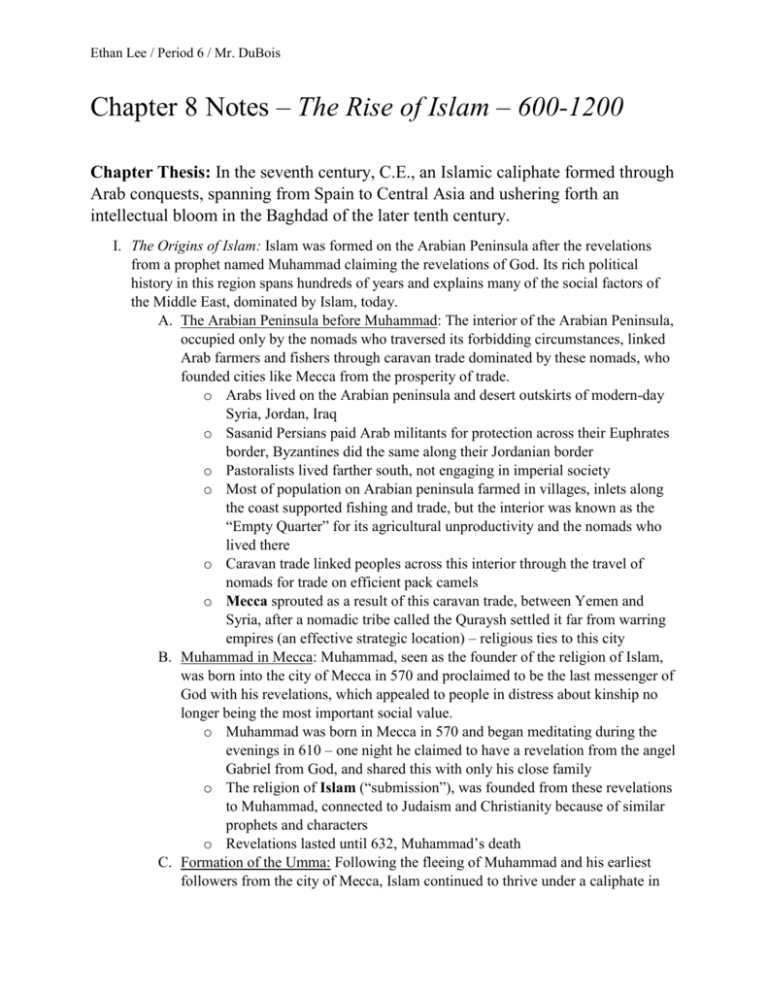
Ethan Lee / Period 6 / Mr. DuBois Chapter 8 Notes – The Rise of Islam – 600-1200 Chapter Thesis: In the seventh century, C.E., an Islamic caliphate formed through Arab conquests, spanning from Spain to Central Asia and ushering forth an intellectual bloom in the Baghdad of the later tenth century. I. The Origins of Islam: Islam was formed on the Arabian Peninsula after the revelations from a prophet named Muhammad claiming the revelations of God. Its rich political history in this region spans hundreds of years and explains many of the social factors of the Middle East, dominated by Islam, today. A. The Arabian Peninsula before Muhammad: The interior of the Arabian Peninsula, occupied only by the nomads who traversed its forbidding circumstances, linked Arab farmers and fishers through caravan trade dominated by these nomads, who founded cities like Mecca from the prosperity of trade. o Arabs lived on the Arabian peninsula and desert outskirts of modern-day Syria, Jordan, Iraq o Sasanid Persians paid Arab militants for protection across their Euphrates border, Byzantines did the same along their Jordanian border o Pastoralists lived farther south, not engaging in imperial society o Most of population on Arabian peninsula farmed in villages, inlets along the coast supported fishing and trade, but the interior was known as the “Empty Quarter” for its agricultural unproductivity and the nomads who lived there o Caravan trade linked peoples across this interior through the travel of nomads for trade on efficient pack camels o Mecca sprouted as a result of this caravan trade, between Yemen and Syria, after a nomadic tribe called the Quraysh settled it far from warring empires (an effective strategic location) – religious ties to this city B. Muhammad in Mecca: Muhammad, seen as the founder of the religion of Islam, was born into the city of Mecca in 570 and proclaimed to be the last messenger of God with his revelations, which appealed to people in distress about kinship no longer being the most important social value. o Muhammad was born in Mecca in 570 and began meditating during the evenings in 610 – one night he claimed to have a revelation from the angel Gabriel from God, and shared this with only his close family o The religion of Islam (“submission”), was founded from these revelations to Muhammad, connected to Judaism and Christianity because of similar prophets and characters o Revelations lasted until 632, Muhammad’s death C. Formation of the Umma: Following the fleeing of Muhammad and his earliest followers from the city of Mecca, Islam continued to thrive under a caliphate in Ethan Lee / Period 6 / Mr. DuBois Medina, albeit with its respective disagreements and divisions among their people over the rightful heir of the caliph, leading to the sects of Sunnis and Shi’ites. o Threatened by the prospect that Muhammad’s claim to be the only messenger for God could undermine their power, Mecca’s leadership pressured Muhammad to leave o Muhammad and his followers fled to the agricultural town of Medina – this fleeing is marked on the Muslim calendar as the “hijra” o Muhammad’s people and the people of Medina bound together in a community called an umma, defined by its devotion to Islam o Muslims of Medina eventually began attacking the city of Mecca, which surrendered in 630 while Medina became a busy city-state and a hub for Islam for the world o Muhammad died of illness in 632 and it was decided that Abu Bakr, one of his closest friends, would succeed him – he was the new caliph (khalifa) o Abu Bakr affirmed the teachings of Muhammad and established the Five Pillars of Islam o Quran was ordered to be compiled from the revelations of Muhammad and took its final form around 650 o Third caliph – Uthman – was assassinated, rebels nominate Ali (Muhammad’s first cousin), forming the faction of Islam known as the Shi’ites, who believe that Ali was the rightful heir o Ali defeated initial opponents, but Mu’awiya and arbitrator claimed that Ali had been wrong in succeeding Uthman, who did not deserve death – Ali murdered by a supporter of the arbitration o Mu’awiya founded the Umayyad Caliphate with his son as the caliph but Husayn from the family of Ali attempted to regain power and was killed along with his family o Divisions of Sunnis and Shi’ites exist along the organization of the caliphate; Shi’ites see the caliph as more secular and are the minor sect II. The Rise and Fall of the Caliphate, 632-1258: As Islamic caliphates continued in conquest, the society rose to one of widespread religion in the community, but by the late 800s, this model of government lead by a caliph began to decline as they lost influence. A. The Islamic Conquests, 634-711: In continuing conquest from Syria and Egypt to Spain and the Indus Valley, the Islamic caliphate expanded in influence and structured according to both the teachings of Muhammad and the edict of the caliph. o Conquests began under second caliph of Umar, taking over Syria and Egypt from the Byzantine Empire and destroyed the Sasanids o Decade passes and Tunisia is taken after its fall, organized for the attacks on Spain from North Africa and Sind from Iraq o Sub-Saharan Africa received Islam through peaceful trade influence o Muhammad personally oversaw conquest of these territories Ethan Lee / Period 6 / Mr. DuBois o Umar forbade Arabs from taking ownership of conquered territory and tied military service to live in camps for readiness B. The Umayyad and Early Abbasid Caliphates, 661-850: During the rule of the Abbasid dynasty, which arose after the Umayyad caliphate fell following political unrest from newly converted Muslims, religion, technology, and literature developed. o Umayyad dynasty was less of a religious state and more of an Arab empire, although their armies were almost completely comprised of Muslim Arabs o Umayyad empire fell in 750 from political unrest; Islam converts resented Arab domination over social and government affairs o In the Khurasan region of modern-day Iran, Shi’ites supported a rebellion in which they believed to be defending the family of Ali; the family of Abbas had coordinated the rebellion however and established the Abbasid Caliphate o Under the Abbasid Caliphate, Islamic theology and scholarly work flourished and great Greek and Persian works were translated C. Political Fragmentation, 850-1050: The Abbasid Caliphate began to see difficulty in governing its centralized empire after both land size and fragmentation increased, causing multiple invasions, while other caliphates were founded and challenged the Abbasids. o During the second half of the ninth century, adoption of Islam had accelerated greatly and the expanse of the empire was difficult to govern with limits on communication between the military and the government o When Muslims became a majority over the region and it was not feasible for the religion to be overthrown, it was realized that centralized government was not best for all of its factions o Islamic community began revolting Arab dominion and formed local municipalities that did not comply to Abbasid taxes or laws o With local territories breaking away, low revenues, distrusting military – crisis in the empire led to the purchase of Turkish mamluks, or slaves for an army – further drained resources from expenses of pay o 740: in the west, Berbers revolt against the rule of Arabs and result in the city-states of Sijilmasa and Tahert, which became very wealthy cities from trade o 875: in the east, Samanid dynasty established a court in Bukhara along the Silk Road o 945: Abbasid Caliphate fell to mountain warriors in northern Iran, led by Buyid family with Shi’ite alignment o Ghana, Mali, Mauritania, and Senegal all became city-states from the exchange system and influence of the caliphate (under a peaceful conversion to Islam, unlike other territories caliphates conquered) Ethan Lee / Period 6 / Mr. DuBois o Fatimid dynasty: claimed to be Shi’ite Imams from the family of Ali, began in Tunisia in 909 – conquered Egypt in 969 and founded Cairo o Spain under the Umayyad Caliphate developed a culture with Roman, Germanic, and Jewish influences into Islamic tradition D. Assault from Within and Without, 1050-1258: The period of Crusaders and the rule of the Seljuk dynasty as a Muslim Turkish state was one marked by economic decline because of environmental problems and political misfortunates. o 1030s: Seljuk family founded Muslim state for Turkish largely thanks to nomadic dominion o Seljuks pushed back Byzantine Empire further o Under the Seljuks, cities became smaller and pastoralists dominate the agricultural countryside o Crusades III. Islamic Civilization: Although Islam was disrupted frequently because of war, the religion evolved in social structure, legal implementation, and freedom of expression. A. Law and Dogma: The foundation of Islam, its law, is called the “Shari’a,” which developed over time to govern social and religious life and to model the behavior of Muhammad himself. B. Converts and Cities: Because of the influence of Islam, Arab military settlements became cities that thrived in the midst of a concentration of cultural activities specifically related to the Muslim religion. C. Women and Slaves: Women existing in an Islamic society in an urban context were secluded and were required to cover themselves with a veil, but their legal status fared better than most other religions at the time. D. The Re-centering of Islam: In the 12th and 13th centuries, religious principles in Islam were further developed and madrasas, or religious schools, were created by scholars



